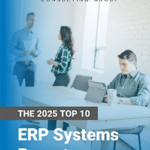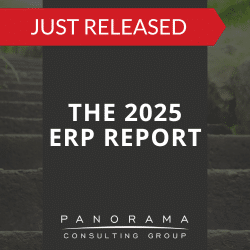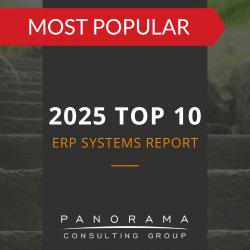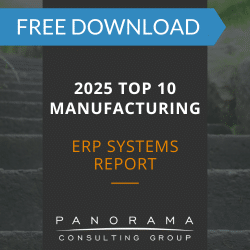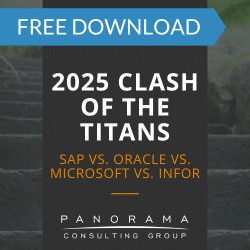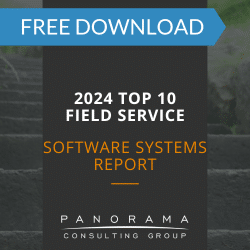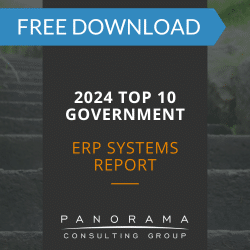- A hybrid ERP system combines on-premise ERP software with cloud-based applications, offering flexibility but introducing integration and security risks.
- Hybrid ERP requires complex integrations, custom middleware, and data synchronization, often leading to higher costs and system misalignment.
- Storing sensitive data across multiple platforms increases the risk of cyberattacks, compliance violations, and unauthorized access.
- A successful hybrid ERP implementation requires a full cost analysis, strong integration frameworks, and unified security policies.
As cloud ERP solutions gain momentum, many organizations hesitate to abandon their legacy on-premise systems entirely. The result? A hybrid ERP strategy—a combination of on-premise ERP software and cloud-based applications designed to offer flexibility without full-scale migration.
At first glance, this seems like a win-win. Businesses retain control over core processes while leveraging the agility and cost-effectiveness of the cloud. But the reality is far more complicated.
Hybrid ERP introduces significant risks—from integration breakdowns and security vulnerabilities to compliance concerns and hidden costs.
Today, we’re exploring the long-term implications of a hybrid approach, so you can set realistic expectations.
A Failed Payroll System Implementation
Panorama’s Expert Witness team was retained to provide a forensic analysis and written report to the court regarding the failed implementation of a major software developer’s ERP/payroll system.
Hybrid ERP Implementation Challenges
Many organizations underestimate the complexity of implementing a hybrid ERP system. In our work as ERP business consultants, we have seen many organizations struggle with hybrid ERP challenges, often leading to ERP failures that could have been avoided with a better-informed strategy.
1. Integration Risks
Unlike a traditional ERP upgrade, a hybrid model requires communication between two fundamentally different architectures.
Most legacy ERP systems were never designed to connect with modern cloud applications. As a result, businesses often rely on custom integrations, middleware solutions, or API connectors—each of which adds cost, complexity, and maintenance overhead.
In many of our client engagements, we’ve seen companies struggle with data silos between cloud-based and on-premise applications. For example, when supply chain systems fail to synchronize with procurement, inventory, and logistics processes, businesses face delays, stock shortages, and inaccurate reporting.
2. Security and Compliance Risks
Hybrid ERP security concerns are another major issue. Unlike a fully cloud-based or fully on-premise system, hybrid ERP environments must maintain multiple security frameworks—each with its own vulnerabilities.
One of the most pressing risks is data exposure. Hybrid ERP often means storing sensitive data across multiple locations, increasing the risk for cyberattacks.
Even more concerning is identity and access management (IAM). With employees, vendors, and partners accessing ERP data from different platforms, businesses must ensure consistent authorization and security protocols across all systems. Misconfigurations in IAM can result in unauthorized access, insider threats, or compliance violations.
Industries such as healthcare, finance, and manufacturing face additional challenges due to strict regulatory requirements. Hybrid ERP environments must comply with data sovereignty laws, industry regulations, and internal governance policies—all while ensuring that security policies are uniform across both cloud and on-premise systems.
3. The Financial Risks of a Hybrid ERP Strategy
Many executives assume that a hybrid ERP model will be more cost-effective than a full cloud migration. In reality, the opposite is often true.
Hybrid ERP introduces hidden costs that businesses fail to anticipate, including:
- Duplicate Licensing Fees – Organizations may need to pay for both on-premise and cloud software licenses.
- Ongoing Integration Maintenance – APIs, middleware, and third-party connectors require constant updates and monitoring.
- Higher IT Labor Costs – Managing two separate ERP environments demands additional IT resources.
Additionally, businesses risk vendor lock-in when integrating cloud applications with legacy ERP systems. Many cloud ERP providers prioritize their own ecosystem, making it difficult to replace or upgrade individual components without costly reimplementation.
How to Mitigate Hybrid ERP Risks
Some key steps to mitigate hybrid ERP risks include:
- Conduct a Full Cost Analysis – Many organizations underestimate the total cost of hybrid ERP. A detailed financial evaluation can help determine whether a hybrid strategy truly delivers cost savings.
- Develop a Strong Integration Framework – Rather than relying solely on vendor-provided connectors, businesses should invest in flexible middleware solutions that allow seamless communication between cloud and on-premise systems.
- Implement Unified Security Policies – Security should be consistent across all ERP environments. This means:
- Data encryption protocols for both cloud and on-premise storage.
- Regular security audits to identify vulnerabilities across the hybrid infrastructure.
- Work with an Independent ERP Business Consultant – Many ERP vendors promote hybrid models as an easy transition to the cloud. Sales hype can easily overshadow your business goals, so working with an independent expert is essential for making an unbiased decision.
Is Hybrid ERP a Temporary Fix or a Long-Term Solution?
While hybrid ERP is often thought of as a transitional strategy, it’s not inherently a short-term approach. For some businesses, particularly those in highly regulated industries, a hybrid ERP strategy can be a viable long-term solution—if managed properly.
In fact, hybrid ERP works well for organizations that need on-premise control for certain functions (e.g., manufacturing execution systems, regulatory compliance), but want to leverage the cloud for scalability and innovation (e.g., analytics, customer engagement).
Executives must continuously evaluate their ERP roadmap, ensuring that technology investments align with long-term growth objectives. In many cases, a gradual shift to a full cloud ERP system will provide greater scalability, reduced IT overhead, and improved data security in the long run.
By making informed, strategic ERP decisions, businesses can avoid costly ERP failures while ensuring that their systems support growth.
Learn How to Combine On-premise and Cloud ERP Successfully
Considering a hybrid ERP strategy? Before making a decision, it’s crucial to assess whether it aligns with your organization’s long-term digital transformation goals.
At Panorama Consulting, we specialize in independent ERP selection and digital transformation consulting, helping businesses navigate the complexities of on-premise and cloud ERP implementation, integration, and vendor negotiations.
To discuss your IT strategy with an experienced ERP business consultant, contact us today.
